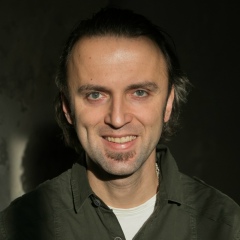К вопросу о мифологическом и научном видении мира.
Во второй части книги "Тысячеликий герой" антрополог Джозеф Кемпбелл рассматривает космогонические мифы (мифы об образовании мира). Во многих мифологиях - в греческой орфической, египетской, финской, буддийской, японской, присутствует образ "Космического яйца".
«Вначале этот [мир] был несуществующим. Он стал существующим. Он стал расти. Он превратился в яйцо. Оно лежало в продолжение года. Оно раскололось. Из двух половин скорлупы яйца одна была серебряной, другая – золотой. Серебряная [половина] – это земля, золотая – небо, внешняя оболочка – горы, внутренняя оболочка – облака и туман, сосуды – реки, жидкость в зародыше – океан. И то, что родилось, это солнце»
После этой цитаты из Чхандогья-Упанишады (ведийского текста на санскрите) Кэмбелл приводит следующую:
«Пространство безгранично, будучи постоянно возобновляющейся формой, а вовсе не ширясь до бесконечности. То, что есть, является скорлупой, плавающей в бесконечности того, чего нет» Это краткая формулировка физика, А.С. Эддингтона, рисующая картину мира, какой он ее видел в 1928 г.
Первое "кстати": Эддингтон был одним из первых учёных, кто, оценив важность специальной и общей теории относительности Эйнштейна, начал интересоваться ими и публиковать статьи по этой теме.
Второе "кстати": Теорию современных физиков о большом взрыве впервые сформулировал Джордж Леметр, католический священник из Бельгии.
Совершенно не важно как мы представляем зарождение мира-вселенной, раскололось ли космическое яйцо или же случилось расширение космологической сингулярности - суть одна и все про одно.
Во второй части книги "Тысячеликий герой" антрополог Джозеф Кемпбелл рассматривает космогонические мифы (мифы об образовании мира). Во многих мифологиях - в греческой орфической, египетской, финской, буддийской, японской, присутствует образ "Космического яйца".
«Вначале этот [мир] был несуществующим. Он стал существующим. Он стал расти. Он превратился в яйцо. Оно лежало в продолжение года. Оно раскололось. Из двух половин скорлупы яйца одна была серебряной, другая – золотой. Серебряная [половина] – это земля, золотая – небо, внешняя оболочка – горы, внутренняя оболочка – облака и туман, сосуды – реки, жидкость в зародыше – океан. И то, что родилось, это солнце»
После этой цитаты из Чхандогья-Упанишады (ведийского текста на санскрите) Кэмбелл приводит следующую:
«Пространство безгранично, будучи постоянно возобновляющейся формой, а вовсе не ширясь до бесконечности. То, что есть, является скорлупой, плавающей в бесконечности того, чего нет» Это краткая формулировка физика, А.С. Эддингтона, рисующая картину мира, какой он ее видел в 1928 г.
Первое "кстати": Эддингтон был одним из первых учёных, кто, оценив важность специальной и общей теории относительности Эйнштейна, начал интересоваться ими и публиковать статьи по этой теме.
Второе "кстати": Теорию современных физиков о большом взрыве впервые сформулировал Джордж Леметр, католический священник из Бельгии.
Совершенно не важно как мы представляем зарождение мира-вселенной, раскололось ли космическое яйцо или же случилось расширение космологической сингулярности - суть одна и все про одно.
To the question of the mythological and scientific vision of the world.
In the second part of the book The Millennium Hero, anthropologist Joseph Campbell examines cosmogonic myths (myths about the formation of the world). In many mythologies - in Greek Orphic, Egyptian, Finnish, Buddhist, Japanese, there is an image of the "Cosmic Egg".
“At the beginning, this [world] was nonexistent. He has become existing. He began to grow. He turned into an egg. It lay throughout the year. It has cracked. Of the two halves of the egg shell, one was silver and the other golden. Silver [half] is the earth, gold is the sky, the outer shell is mountains, the inner shell is clouds and fog, the vessels are rivers, the liquid in the bud is the ocean. And what was born is the sun. "
After this quotation from the Chandogya Upanishad (Vedic Sanskrit text), Campbell gives the following:
“Space is unlimited, being a constantly renewing form, and not expanding to infinity. That which is is a shell floating in the infinity of that which is not. ”This is a brief statement of the physicist, A. S. Eddington, painting a picture of the world as he saw it in 1928
First “by the way”: Eddington was one of the first scientists who, appreciating the importance of Einstein's special and general theory of relativity, began to be interested in them and publish articles on this topic.
Second “by the way”: The theory of modern physicists about the big bang was first formulated by George Lemeter, a Catholic priest from Belgium.
It doesn’t matter how we imagine the birth of the world-universe, whether the cosmic egg has cracked or if the expansion of the cosmological singularity has happened - the essence is one and all about one.
In the second part of the book The Millennium Hero, anthropologist Joseph Campbell examines cosmogonic myths (myths about the formation of the world). In many mythologies - in Greek Orphic, Egyptian, Finnish, Buddhist, Japanese, there is an image of the "Cosmic Egg".
“At the beginning, this [world] was nonexistent. He has become existing. He began to grow. He turned into an egg. It lay throughout the year. It has cracked. Of the two halves of the egg shell, one was silver and the other golden. Silver [half] is the earth, gold is the sky, the outer shell is mountains, the inner shell is clouds and fog, the vessels are rivers, the liquid in the bud is the ocean. And what was born is the sun. "
After this quotation from the Chandogya Upanishad (Vedic Sanskrit text), Campbell gives the following:
“Space is unlimited, being a constantly renewing form, and not expanding to infinity. That which is is a shell floating in the infinity of that which is not. ”This is a brief statement of the physicist, A. S. Eddington, painting a picture of the world as he saw it in 1928
First “by the way”: Eddington was one of the first scientists who, appreciating the importance of Einstein's special and general theory of relativity, began to be interested in them and publish articles on this topic.
Second “by the way”: The theory of modern physicists about the big bang was first formulated by George Lemeter, a Catholic priest from Belgium.
It doesn’t matter how we imagine the birth of the world-universe, whether the cosmic egg has cracked or if the expansion of the cosmological singularity has happened - the essence is one and all about one.

У записи 7 лайков,
1 репостов.
1 репостов.
Эту запись оставил(а) на своей стене Павел Щипков



























![Олег Яковлев [ведущий] Олег Яковлев [ведущий]](https://sun9-51.vkuserphoto.ru/s/v1/ig1/AeDXSOOHI4vVn2yceds1BO9Ur99Yn-1AmUX8_8iPPHzTWH2c9wRsg-og3Xz4Bvh4WfngNz-m.jpg?quality=96&crop=64,90,463,463&as=32x32,48x48,72x72,108x108,160x160,240x240,360x360&ava=1&cs=200x200)
